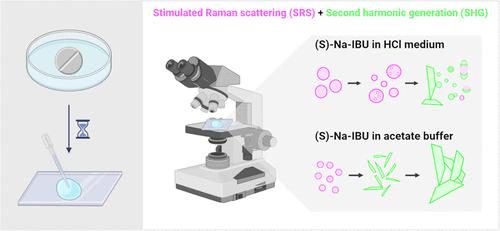液-液分离的化学特异性相干拉曼成像及其后遗症
IF 6.7
1区 化学
Q1 CHEMISTRY, ANALYTICAL
引用次数: 0
摘要
液-液相分离在材料科学中从细胞结构重组到晶体结构形成等过程中起着举足轻重的作用。在制药领域,它已经被证明可以影响药物的结晶和传递。迄今为止,LLPS的表征仅限于非空间分辨或非化学分辨分析。在这项研究中,我们首次使用化学特异性受激拉曼散射(SRS),结合二次谐波产生(SHG),来成像LLPS存在下的结晶。利用模型化合物布洛芬,我们研究了LLPS与结晶之间的相互作用,并探讨了溶解介质和对映体形式对这种行为的影响。在此过程中,我们还发现并部分表征了(S)-布洛芬的新多晶型。我们的研究结果证明了相关的SRS和SHG在实时监测相分离和结晶方面的潜力,为相分离畴和新形成晶体的空间分布、化学成分和结构提供了机制见解。这种见解不仅有利于制药开发,而且有利于生物医学、食品和化学部门。本文章由计算机程序翻译,如有差异,请以英文原文为准。

Chemically Specific Coherent Raman Imaging of Liquid–Liquid Phase Separation and Its Sequelae
Liquid–liquid phase separation (LLPS) plays a pivotal role in processes ranging from cellular structure reorganization to the formation of crystalline structures in materials science. In the pharmaceutical field, it has been demonstrated to impact drug crystallization and delivery. To date, characterization of LLPS has been limited to nonspatially resolved or nonchemically resolved analyses. In this study, we employed chemically specific stimulated Raman scattering (SRS), combined with second harmonic generation (SHG), for the first time to image crystallization in the presence of LLPS. Using the model compound ibuprofen, we examined the interplay between LLPS and crystallization, and explored the influence of both dissolution medium and enantiomeric form on this behavior. In doing so, we also discovered and partially characterized a new polymorph of (S)-ibuprofen. Our results demonstrate the potential of correlative SRS and SHG for monitoring phase separation and crystallization in real time, giving mechanistic insights into the spatial distribution, chemical composition and structure of phase-separated domains and newly formed crystals. Such insights could benefit not only pharmaceutical development, but also the biomedical, food and chemical sectors.
求助全文
通过发布文献求助,成功后即可免费获取论文全文。
去求助
来源期刊

Analytical Chemistry
化学-分析化学
CiteScore
12.10
自引率
12.20%
发文量
1949
审稿时长
1.4 months
期刊介绍:
Analytical Chemistry, a peer-reviewed research journal, focuses on disseminating new and original knowledge across all branches of analytical chemistry. Fundamental articles may explore general principles of chemical measurement science and need not directly address existing or potential analytical methodology. They can be entirely theoretical or report experimental results. Contributions may cover various phases of analytical operations, including sampling, bioanalysis, electrochemistry, mass spectrometry, microscale and nanoscale systems, environmental analysis, separations, spectroscopy, chemical reactions and selectivity, instrumentation, imaging, surface analysis, and data processing. Papers discussing known analytical methods should present a significant, original application of the method, a notable improvement, or results on an important analyte.
 求助内容:
求助内容: 应助结果提醒方式:
应助结果提醒方式:


